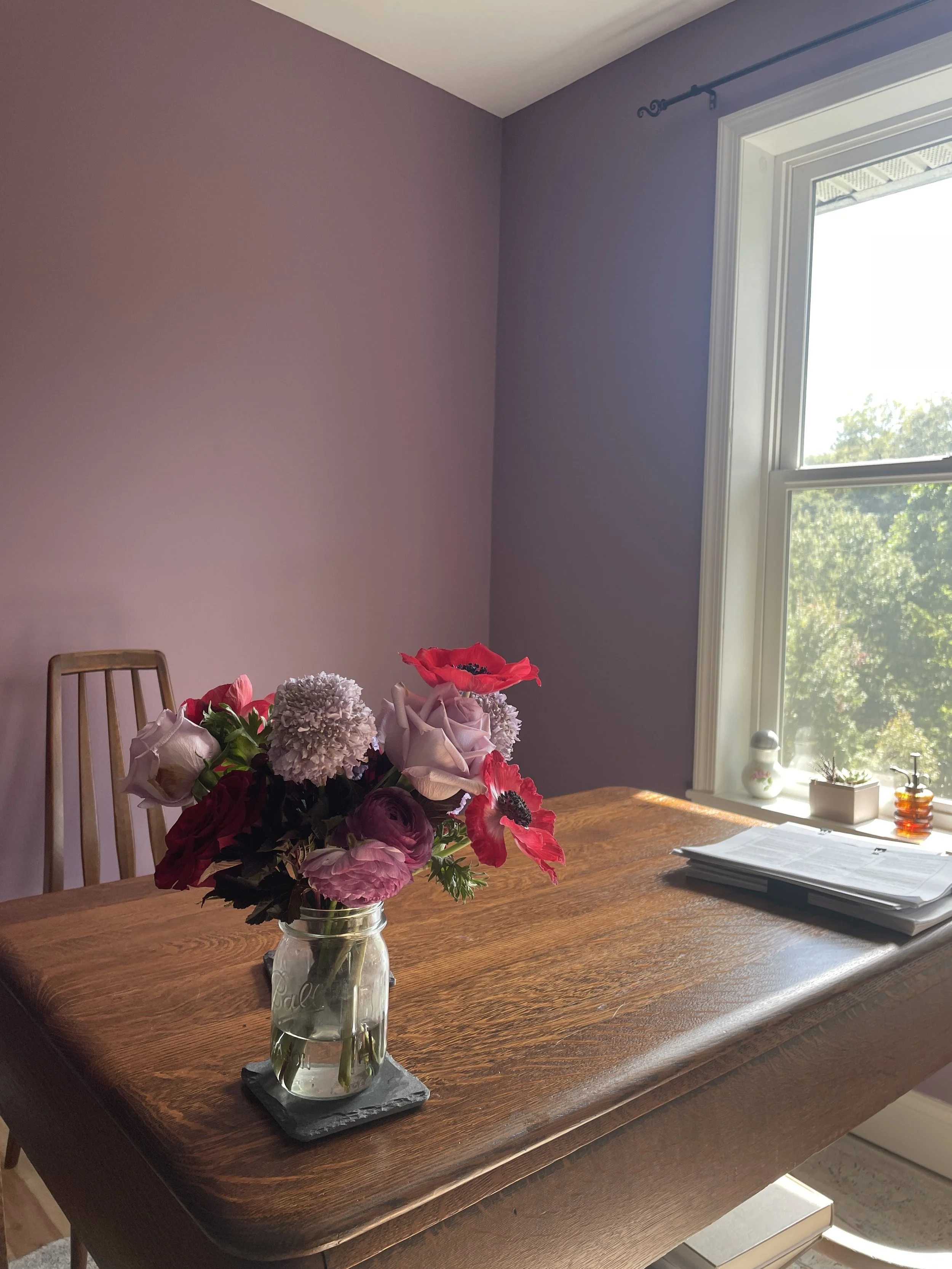Urgent and Slow at the Same Time
A little blooming on my desk — a reminder that the slow, tender work matters too.
Learning How to Slow Down in a Fast-Paced World
Hello Courageous Thrivers,
Lately, I’ve been thinking about what it means to slow down in a fast-paced world that’s asking for our urgent attention.
I recently attended Creative Mornings, Baltimore, as I often do.
I almost never want to go.
I am always glad when I do.
In case you haven’t heard about these amazing gatherings, they happen monthly all around the world. They’re free, there’s a global theme, a local creative speaker, and they attract all kinds of people — artists, entrepreneurs, researchers.
In Baltimore, they move locations each month. (I’m not sure if that’s the case elsewhere.) You can learn more and see if there’s one in your city by following this link.
This particular gathering was hosted by the Baltimore Museum of Art, and the theme for the month was Bloom.
The first speaker shared about the museum’s new wildflower garden — part of their ongoing commitment to positive environmental impact.
As she described the process of tearing up grass and replanting with wildflowers, she said two things that have stayed with me:
Their environmental work is “both urgent and slow at the same time.”
The landscape architects warned them that the plot would be ugly for a while.
A tough pill to swallow for an art museum — but they decided it was worth it.
Urgency and Patience Can Coexist
Most important work is both urgent and slow at the same time.
In this moment in history, it feels urgent that many more of us step out of overwhelm and into action. It matters that we don’t stay in complacency. It matters that we learn to feel and process big, uncomfortable emotions — without letting them take us out of the game.
The Earth is suffering.
People are suffering.
Plants, animals, whole ecosystems are suffering.
We each have a part to play by being fully ourselves — especially those of us with privileges we aren’t yet using the way we want to.
But/and/also...
Urgency culture is not what we’re going for here.
It’s one of the characteristics of white-supremacist patriarchy — a reflection of our collective, unhealed trauma.
We don’t want that energy running the show — not in our movements, not in our bodies, not in our communities.
It’s urgent that we start.
But we must also move slowly at the same time.
The shift in consciousness humanity needs — to choose love and connection over fear and violence — requires people who slow down, listen, meditate, and pray.
Building new, interdependent, loving economies is slow work.
There’s no quick fix.
Ways of being that are deeply rooted in right relationship with this Earth, and with one another, take time. They require patience, humility, and tending.
When our past traumas are triggered by current events — which is totally understandable — we must first pause.
We must slow everything down until our body, mind, and heart can take a breath.
Then we can hear that still, small voice that shows us our next step.
Ask yourself:
If everything feels urgent right now, can you step outside and put your feet on the ground?
Can you lie on your back, put your legs up a wall, and listen to calming music for five minutes?
Can you ask for guidance from Nature, your ancestors, angels, or your own heart — and then trust the message you receive?
Small steps taken consistently over time make for big change.
Sometimes things are ugly for a while before the blooming starts.
At the museum, they tore up the old turf to make space for the wildflowers.
Sometimes, removing the old — what’s no longer serving — is our choice. (That doesn’t mean it doesn’t hurt.)
Other times, it’s removed for us.
Either way, that barren ground doesn’t look like much… until the blooms arrive.
Making it through this part of the growth cycle requires vision, faith, and daily tending to the life that has yet to come into view.
My prayer for you today is that you find faith that your blooming will come — and that you act as if that is true.
After the planting, museum staffers sat outside with their lunches for weeks — watching, believing, not giving up.
So today, I’m here to say to you — in case you need to hear it —
Don’t give up.
I am holding a vision for your blooming, and for the blooming of your work in the world.
And if you’re already there, surrounded by blossoms — hooray.
The world needs your joy right now.
Revel in the beauty.
Here’s to thriving and equity,
and doing our big work — both urgent and slow — with patience and faith.
Deb
Reflections: What It Means to Move Urgent and Slow
Q: How do I stay calm when the world feels urgent?
A: Start with your body. Slow your breath, put your feet on the earth, and remember that small consistent steps create lasting change.
Q: Why is slowing down important in activism and leadership?
A: Because urgency without presence recreates the same harm we’re trying to heal. The world doesn’t need more speed—it needs more steadiness.
Additional Reading
If this theme speaks to you, you might also enjoy reading Slow and Steady about staying grounded in long-haul work.
A little blooming happening for me here — I'm learning to relax and trust myself when I go clothes-shopping, and not be afraid to stand out in a crowd.
If this reflection spoke to you, and you’re craving a slower, more embodied way to do the urgent work of change, learn more about my 1:1 coaching.

